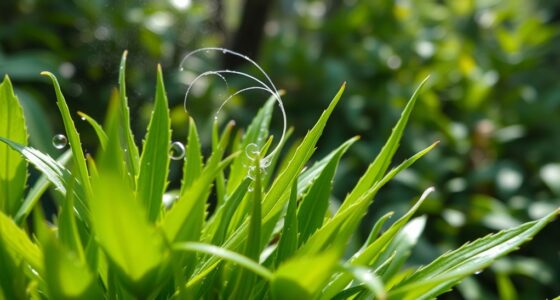Yes, coral gardening shows great promise for saving reefs one fragment at a time. By carefully collecting healthy coral fragments, nurturing them in controlled nurseries, and transplanting them onto damaged reefs, you can help rebuild these ecosystems efficiently. This approach accelerates coral growth and boosts resilience against stressors like heat and disease. If you want to discover how small efforts can make a big difference in reef recovery, keep exploring these innovative methods.
Key Takeaways
- Coral gardening accelerates reef recovery by propagating healthy fragments for transplantation onto degraded reefs.
- Nurseries enable rapid growth of resilient coral fragments, increasing transplantation success rates.
- Restoring reefs with coral fragments enhances biodiversity, water quality, and reef resilience against climate stress.
- Community involvement in coral gardening fosters stewardship and expands conservation efforts worldwide.
- Small coral fragments, when carefully cultivated and transplanted, can significantly contribute to reef conservation and recovery.

Have you ever wondered how scientists and conservationists restore damaged coral reefs? It’s a fascinating process that involves coral propagation and reef restoration techniques designed to give these essential ecosystems a second chance. Coral gardening is at the forefront of this effort, focusing on cultivating healthy corals in controlled environments before reintroducing them to their natural habitats. This method offers hope for reefs suffering from pollution, warming temperatures, and destructive human activities. When you understand the steps involved, it becomes clear that each small fragment can make a big difference in saving entire reef systems.
Coral restoration offers hope by transforming tiny fragments into thriving, resilient ecosystems.
The process begins with collecting healthy coral fragments, often called “cuttings,” from thriving colonies. These fragments are then carefully propagated in specialized nurseries, where they’re nurtured until they grow strong enough to be transplanted back into degraded reefs. Coral propagation in these nurseries mimics natural growth, but accelerates it, allowing conservationists to produce large numbers of resilient corals in a shorter period. Once the corals reach an appropriate size, they are carefully outplanted onto the reef, where they continue to grow and contribute to reef restoration efforts. This targeted approach helps rebuild the structural complexity of reefs, providing habitats for countless marine species and supporting local communities.
Reef restoration through coral gardening isn’t just about planting corals; it’s about restoring the delicate balance of these ecosystems. Each successful transplantation boosts biodiversity, improves water quality, and enhances the reef’s resilience against future threats. You might think that restoring a reef sounds slow or uncertain, but with advances in coral propagation techniques, scientists can now target specific coral species that are more resistant to heat stress and disease. This strategic selection increases the likelihood of long-term success, turning small fragments into thriving new colonies. Additionally, the development of high-quality nursery facilities has improved the survival rates of transplanted corals, making restoration efforts more effective.
The beauty of coral gardening lies in its adaptability and community involvement. Many projects involve local communities, empowering them to participate in reef restoration and fostering a sense of stewardship. By actively engaging in reef restoration, you become part of a global effort to combat coral decline. Every fragment planted is a step toward rebuilding what’s been lost, turning the tide against coral bleaching and destruction. In essence, coral propagation and reef restoration through coral gardening prove that even the tiniest fragments can be powerful tools for saving our oceans’ most delicate, yet crucial, ecosystems.
Frequently Asked Questions
How Long Does It Take for Coral Fragments to Mature?
When wondering how long coral fragments take to mature, keep in mind that the coral growth and maturation timeline vary depending on the species and conditions. Typically, it takes anywhere from 6 months to several years for coral fragments to reach a size where they can start reproducing. You can speed up this process by providing ideal water quality, light, and nutrients, but patience is key in observing full maturation.
What Are the Biggest Challenges in Coral Gardening?
You might be surprised to learn that habitat compatibility tops the list of challenges in coral gardening. Ensuring fragments adapt to local conditions is tough, and limited genetic diversity can hinder resilience. When corals aren’t suited to their environment or lack genetic variation, recovery slows. You need to carefully select and match coral strains to their habitats, or else efforts may not succeed. This makes overcoming habitat compatibility and boosting genetic diversity vital for reef restoration success.
Can Coral Gardening Restore Severely Damaged Reefs?
Severely damaged reefs pose a tough challenge for restoration, but coral gardening offers hope. By carefully selecting and planting coral fragments, you can help restore genetic diversity, which strengthens the reef’s ability to adapt. This process boosts ecosystem resilience, making reefs more resistant to threats like climate change and pollution. While it’s not a complete fix, coral gardening can markedly support the recovery of severely damaged reefs over time.
How Cost-Effective Is Coral Gardening Compared to Other Conservation Methods?
You’ll find that coral gardening is generally cost-effective compared to other conservation methods, especially when considering its targeted approach. A clear cost comparison shows it often requires less funding upfront and can be scaled more easily. Funding strategies, like community involvement and partnerships, further boost its affordability. Overall, coral gardening offers a practical, budget-friendly option to restore reefs, making it a smart investment for marine conservation efforts.
Are There Any Risks of Introducing Diseases Through Coral Fragments?
You should be aware that disease transmission is a potential risk when introducing coral fragments, especially if they carry pathogens. This can threaten existing reef health and reduce genetic diversity, making corals more vulnerable. To minimize these risks, proper screening and quarantine protocols are essential. By doing so, you help protect reef ecosystems from disease outbreaks and support the resilience of coral populations, ensuring long-term conservation success.
Conclusion
By actively participating in coral gardening, you can help restore vibrant reefs one fragment at a time. This hands-on approach proves that small efforts truly make a difference, offering hope for reef recovery. Scientific studies support the idea that targeted restoration boosts marine biodiversity and resilience. So, believe in the power of your actions—every coral fragment you nurture brings us closer to preserving these precious ecosystems for future generations.









